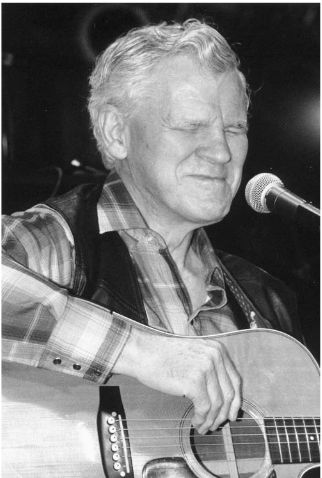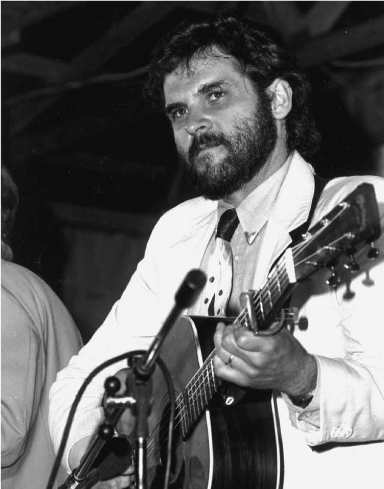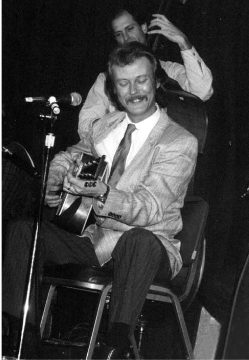This section contains excerpts from our eight volume Flatpicking Essentials course.
The Heroes Era of Flatpicking and Bluegrass Guitar
 Arthel “Doc” Watson is the man who is typically viewed as the “father” of the flatpicking style. While he was playing in a dance band, Jack Williams and the Country Gentlemen, in the mid-to-late 1950s, Doc was called upon to play fiddle tunes on the guitar. Williamsʼ band did not have a fiddle player about 90% of the time, however, the dance halls that hired the band would usually want them to do a square dance set. Williams, who had heard Doc fooling around with a few fiddle tunes on the guitar, suggested that Doc learn how to play lead on some fiddle tunes. During the “folk boom” of the early 1960s, Doc began performing as a solo act on the acoustic guitar and by the mid-sixties was traveling as a duo with his son Merle. Doc adapted his fiddle tune picking style to the acoustic guitar and folk music enthusiasts were amazed at Watson’s ability to play fluid lead lines at fast tempos on the acoustic guitar. Arthel “Doc” Watson is the man who is typically viewed as the “father” of the flatpicking style. While he was playing in a dance band, Jack Williams and the Country Gentlemen, in the mid-to-late 1950s, Doc was called upon to play fiddle tunes on the guitar. Williamsʼ band did not have a fiddle player about 90% of the time, however, the dance halls that hired the band would usually want them to do a square dance set. Williams, who had heard Doc fooling around with a few fiddle tunes on the guitar, suggested that Doc learn how to play lead on some fiddle tunes. During the “folk boom” of the early 1960s, Doc began performing as a solo act on the acoustic guitar and by the mid-sixties was traveling as a duo with his son Merle. Doc adapted his fiddle tune picking style to the acoustic guitar and folk music enthusiasts were amazed at Watson’s ability to play fluid lead lines at fast tempos on the acoustic guitar.
About the same time that Doc Watson began touring the country with his son Merle, several other prominent players in the bluegrass and folk music worlds also began featuring lead guitar work using the flatpicking style. While Doc Watson’s playing had an influence on all of these players to some degree, we cannot say that any of them were simply copying what Doc Watson was doing. We can’t even say that they all began to develop their style after first hearing Doc. Most of the great guitarists who we point to as our heroes were developing their own styles of lead acoustic guitar playing using a flatpick at the same time Doc Watson was touring the country and introducing this style to his audience.
To whatever degree each of our flatpicking heroes has been influenced by Doc Watson’s playing, they each also made their own significant contributions to the style in its formative years and that is why we list them here.
 These prominent players included: Clarence White, Norman Blake, Dan Crary, and Tony Rice as the main “heroes” of flatpicking with additional players such as Larry Sparks, Russ Barenberg, David Bromberg, Pat Flynn, Charles Sawtelle, Mark O’Connor, John Carlini, Phil Rosenthal, Eric Thompson, Joe Carr, and Steve Kaufman also playing important roles. This era of flatpicking history ran from the mid-1960s through the early 1980s. We will call it the “Heroes Era.” These prominent players included: Clarence White, Norman Blake, Dan Crary, and Tony Rice as the main “heroes” of flatpicking with additional players such as Larry Sparks, Russ Barenberg, David Bromberg, Pat Flynn, Charles Sawtelle, Mark O’Connor, John Carlini, Phil Rosenthal, Eric Thompson, Joe Carr, and Steve Kaufman also playing important roles. This era of flatpicking history ran from the mid-1960s through the early 1980s. We will call it the “Heroes Era.”
The Heroes Era was not only the time when the guitar stepped out of the rhythm section and began to be recognized as a lead instrument with its own voice and unique contribution to a band’s sound; it was also an era of exploration beyond traditional boundaries. While Doc Watson continued to add tunes from the blues, old-time, jazz, and folk genres to the standard flatpicking fiddle tune repertoire, Clarence White’s syncopated rhythms and extensive use of crosspicking also pushed flatpicking in new directions. Norman Blake supercharged the Carter chord-melody style by weaving intricate lead lines around rhythmic chordal strums, and Dan Crary brought powerful and expressive lead guitar work to fiddle tune and bluegrass melodies with his 1970 release Bluegrass Guitar.
Tony Rice and Russ Barenberg were two influential flatpickers who picked up what Doc Watson and Clarence White had done and mixed it with jazz influences to become founding members of the “new acoustic” music genre. Pat Flynn and David Bromberg brought in rock and roll influences; Larry Sparks and Charles Sawtelle introduced bluegrass guitar solos that were bluesy and sparse, and Mark O’Connor and Steve Kaufman helped define the contest style of hot and flashy flatpicked fiddle tunes. It was a time of tremendous growth, experimentation, and exploration. Now that the acoustic guitar had an accepted lead voice, flatpicking heroes were discovering new possibilities and avenues of expression and thus expanding the concept of flatpicking itself. As flatpickers embraced songs from standard jazz, Gypsy jazz, rock and roll, blues, Western swing, and Celtic repertoires, flatpicking was no longer restricted to traditional old-time, folk, and bluegrass music.
 It was during the Heroes Era that flatpicking technique also began to change. While this change was ultimately brought on by the creativity of the style’s main proponents, guitar design and technology also had something to do with it. Due to player demands, guitar builders began making instruments that were easier to play up-the-neck and provided a balanced “modern” sound. Sound reinforcement technology also contributed to the change in technique as players did not have to hit the guitar so hard in order to be heard. Flatpickers could now play with a lighter touch, which allowed for better endurance, speed and fluidity. It was during the Heroes Era that flatpicking technique also began to change. While this change was ultimately brought on by the creativity of the style’s main proponents, guitar design and technology also had something to do with it. Due to player demands, guitar builders began making instruments that were easier to play up-the-neck and provided a balanced “modern” sound. Sound reinforcement technology also contributed to the change in technique as players did not have to hit the guitar so hard in order to be heard. Flatpickers could now play with a lighter touch, which allowed for better endurance, speed and fluidity.
The Second Generation
The next era of flatpicking runs from the early-to-mid 1980s through the first few years of the new millennium. During this era flatpicking continued to blossom and grow, building on the foundation laid down by the pioneers and heroes, and then expanding in new directions. We will call this the “Second Generation” era. Interestingly, since all of the heroes continued to record and perform during this era (with the exception of Clarence White who died tragically in 1973), they all continued to play a role in flatpicking growth and development as they themselves evolved as players and performers. The key flatpickers of the second generation include players such as: David Grier, Tim Stafford, Jack Lawrence, Kenny Smith, Brad Davis, Bryan Sutton, Wyatt Rice, James Alan Shelton, Robin Kessinger, Mark Cosgrove, Scott Nygaard, Beppe Gambetta, John Moore, Orin Star, Jim Hurst, Chris Jones, Tim May, Jim Nunally, Dix Bruce, Peter McLaughlin, Sean Watkins, and others.
During the early part of this era many of the young flatpickers simply copied the solos, licks, and overall styles of the heroes who came before them, with Tony Rice being the one who was most frequently “cloned.” As flatpicking approached the 1990s, however, the majority of the players who rose to prominence in the Second Generation had their own signature sound and unique style. David Grier developed a solo style that was based on an incredibly smooth and fluid crosspicking technique and a stream of endless musical ideas; Tim Stafford introduced solos that tastefully and creatively supported the song and overall band sound. He also became well known for his “floating” technique. Brad Davis introduced a “speed picking” technique he called “double-down-up,” which spit notes out like a chainsaw on overdrive. Jim Hurst combined his talents as a country fingerpicker with his flatpicking technique to develop yet another unique flatpicking voice. Bryan Sutton demonstrated that it was indeed possible for a guitar player in a high-energy bluegrass band to play fast and clean with good power, volume and tone.
In addition, Grier, Davis and Sutton also frequently used a “hybrid” fingerpicking and flatpicking technique, which was first introduced to the flatpicking world by Clarence White and also employed by Tony Rice. With this technique the player uses the flatpick, held between the thumb and index finger, in combination with the fingernails of the middle and ring fingers. This technique is something that not only brought the fingerpicking and flatpicking worlds closer together, but it also brought the acoustic and electric worlds closer together since this technique is prominently used by country electric players. Each new prominent player of this era had something unique to offer and each has helped the art of flatpicking to grow, flourish and change.
Developments in cassette, video, CD, and DVD technologies during this era also made it much easier for flatpicking students to learn the licks and solos of their favorite performers and recording artists. By the early eighties, cassette courses from flatpicking heroes Tony Rice, Russ Barenberg, and Dan Crary were available, followed later by video tapes lessons from Norman Blake and Doc Watson. Additionally, Russ Barenberg wrote a book of Clarence White transcriptions. Steve Kaufman and Joe Carr also began to release, through both Homespun Tapes and Mel Bay Publications, a continuous stream of quality instructional material. As time progressed transcription books of nearly every prominent flatpicker became available. Additionally, video lessons by second generation pickers such as David Grier, Tim Stafford, Kenny Smith, James Alan Shelton, Beppe Gambetta, Wyatt Rice, Bryan Sutton, Orrin Star, Brad Davis, Dix Bruce, and others were also made available.
In addition to quality instructional books, CDs, and videos many instructional workshops, clinics, and seminars began popping up all over the country. Most notably, Steve Kaufman’s Acoustic Kamps in Tennessee, Camp Bluegrass in Texas, Rockygrass Academy in Colorado, Roanoke Bluegrass Weekend in Virginia, Bluegrass at the Beach in Oregon, and many others made it easy for flatpicking enthusiasts to spend time learning from their heroes. In 1996 High View Publications also began publishing Flatpicking Guitar Magazine, a bi-monthly publication that explores all aspects of flatpicking the acoustic guitar. Prior to the Second Generation era, anyone who wanted to learn how to flatpick had to spend hours in front of a turntable slowing down recordings made by their heroes in order to learn this challenging guitar style. By the year 2000, anyone who had an interest in learning how to flatpick had opportunities to learn from any of their favorite flatpickers, either in person at a workshop or through their written and videotaped material.
Due to the variety of instructional material available during this era, the art of flatpicking the acoustic guitar became much more accessible to the average amateur flatpicker. Whereas during the heroes era it was rare to see a local hometown band with a skilled lead guitar player, by the year 2000 there was a lead guitar player in nearly every bluegrass band, from the local hometown bands to touring professional bands.
As the ranks of both the flatpicking professionals and hobbyists have risen over the years, the standard flatpicking repertoire has also swelled far beyond its original fiddle tune banks and borders. As flatpickers become more experienced they seek songs and genres of music that present challenges beyond those of simple fiddle tunes. During the Second Generation era far more Western swing, Gypsy jazz, Celtic, and standard jazz tunes (and the techniques that accompany them) have entered the average flatpicker’s repertoire. Today the definition of flatpicking has to extend beyond the genres of American roots music to include just about anything a player can perform using a pick and a steel-string acoustic guitar.
The Next Generation
We will call the fourth era of flatpicking guitar playing the “Next Generation”. This new generation of young players consists of those who have reaped the benefits of the creativity of those who have come before them and have begun to make innovations of their own. These are players who, due to their age, never knew that flatpicking was once confined to playing fiddle tunes. They have grown up hearing Tony Rice playing jazz and new acoustic music with the David Grisman Quintet and are using Rice and Grisman as their starting point. For the most part, their ideas about flatpicking have no boundaries in terms of genre, or the melding of various musical influences and ideas, or the mixing of electric and acoustic guitar techniques.
The Next Generation includes players such as: Cody Kilby, John Chapman, Josh Williams, Chris Eldridge, Andy Falco, Edward O’Day, Adam Wright, Tyler Grant, Matt Arcara, Dillon Hodges, Justin Carbone, Matt Wingate, Jake Stargel, Tony Watt, Megan McCormick, and Mo Canada. These young players are not only including influences from the flatpickers who came before them, they are also incorporating influences from various other musical styles to great effect; furthermore, they are doing so in positions of prominence. Cody Kilby performs with Ricky Skaggs, Josh Williams toured with Rhonda Vincent; Chris Eldridge with the Infamous Stringdusters and the Punch Brothers; Andy Falco with Alecia Nugent and the Infamous Stringdusters; Matt Wingate with the Lovell Sisters and the Greencards; Jake Stargel with the Greencards and the Lovell Sisters; Edward O’Day with Adrienne Young, and Tyler Grant with Drew Emmitt.
In addition to being more musically open-minded and versatile than the average flatpicker of the past, many players in the Next Generation era are also more musically educated. In an interview with Flatpicking Guitar Magazine, Chris Eldridge, who has a college degree in music said, “The new standard is to be educated. Three generation back, guys like Clarence, Doc, and Norman were all intuitive players. Guys like Tony and David Grisman, knew a little more about theory. Today the younger musicians are getting more educated and taking it further. Chris Thile thoroughly knows his theory and he is setting the standard for the next generation. The approach is changing.”
The art of flatpicking the acoustic guitar has come a long way since the day the first guitar player pushed a flatpick through a set of steel strings. While this chapter has briefly discussed the various stages of development the style has undergone during its continual growth, the chapters which follow in this instructional series will provide far greater insights through more detailed discussions of the most prominent and influential players and their milestone recordings, as well as examples of their techniques.
|
|
|